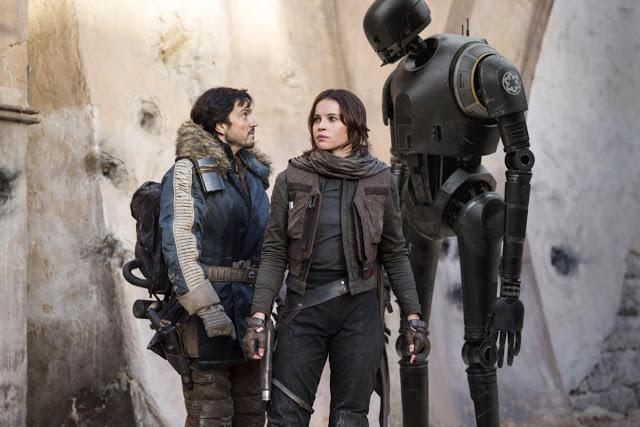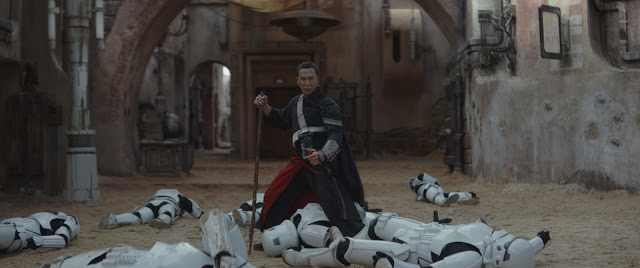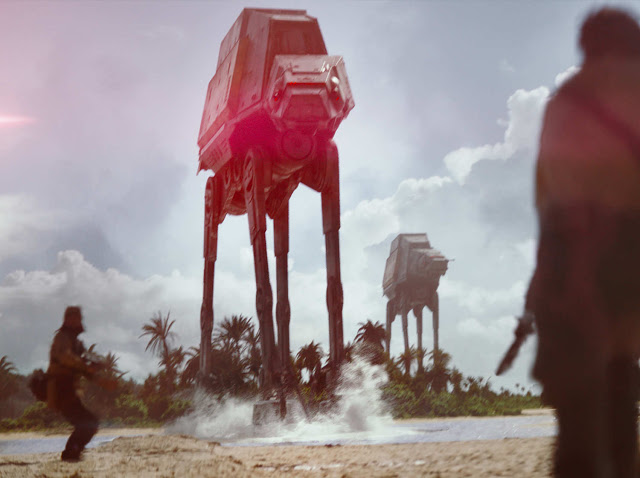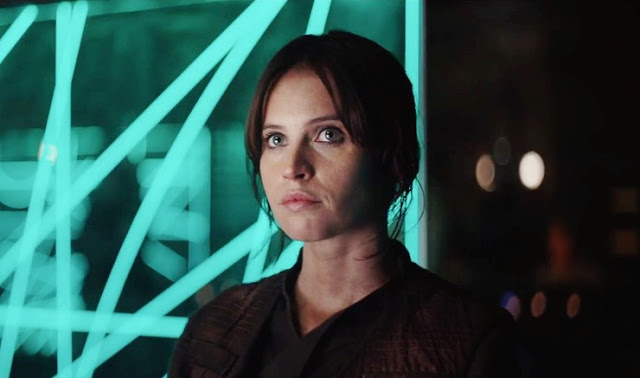Of the infinite memes that sprang out of the original Star Wars trilogy, one of the most random derives from a moment of startling quiet in The Return of the Jedi, when a rebel leader is delivering an expository info-dump. As she’s rambling about battle stations and deflector shields, she suddenly pauses, then drops her voice and solemnly murmurs, “Many Bothans died to bring us this information.” There are no Bothans in Rogue One: A Star Wars Story, but there is quite a bit of death, and not just involving hundreds of haphazardly slaughtered stormtroopers. This counts as a surprise. The Star Wars franchise isn’t devoid of darkness, but it has generally prioritized fun and escapism; while Rogue One largely stays on brand, it isn’t especially concerned with joy. Instead, the predominant theme of this interesting and frustrating film—which was directed by Gareth Edwards from a script by Chris Weitz and Tony Gilroy—is sacrifice. It’s a genuine war movie, one about the soldiers who wade through the mud, risking their lives so that the rest of us may glimpse a better tomorrow.
If that sounds turgid, don’t worry—this is still a Star Wars movie, with all of the excitement and mythology that such an undertaking entails. Yet Rogue One occupies a curious place within Disney’s newest and most profitable cinematic universe. Whereas the official episodic saga resumed last year, after a decade-long layoff, with The Force Awakens, Rogue One is the first of the studio’s “anthology” series, films that both take place within the canonical realm and simultaneously stand apart from it. (Continuing this pattern, 2018 will see the release of a Han Solo movie, starring Hail, Caesar‘s Alden Ehrenreich, while a rumored Boba Fett film is tentatively slated for 2020.) In theory, this concept will allow filmmakers to expand the Star Wars mythos into uncharted space, using the series’ existing, minutely detailed template to tell bold and innovative stories. But because the franchise’s fan base is so entrenched and protective of its collective property—and because directors must satisfy their corporate overlord’s commercial imperative to please those fans—veering too far off course is a dicey proposition.
In broad terms, Rogue One gets this balancing act mostly right. To be sure, it provides a hefty helping of winking fan service: C-3PO pops up to whimper something miserably; Mon Mothma makes an appearance, as do those hotheads from Mos Eisley; Darth Vader casually waves his hand and chokes a hapless underling half-to-death; somebody confesses that he has a bad feeling about this. But these moments function more as playful easter eggs than as the spine of the film’s story, which is, by and large, gratifyingly original. The Force Awakens was for the most part a rousing success, but in essentially mirroring the plot of Star Wars: A New Hope, it betrayed J.J. Abrams’ anxiety—he made certain to stay on target at all costs, lest he inadvertently stumble into an asteroid field. Rogue One is hardly an isolated production—chronologically, it takes place shortly before the events of A New Hope—but its dovetails with extant material feel nimble, less the product of studio engineering than artistic ingenuity.
It also moves like quicksilver, critical for a movie with so much exposition to burn through. Following a foreboding prologue that features a dead mum, a kidnapped dad, and a mournful rescue, Rogue One launches into a flurry of activity. Jyn Erso (Felicity Jones, tough as nails) is a solitary dissident who’s serving time for the Empire while also fighting the memories of her tragic past. She’s broken out of captivity by Cassian Andor (Diego Luna, struggling but eventually finding his form) and his droid, K-2SO (voiced by a funny Alan Tudyk). They’re part of the Rebel Alliance, and they’re hoping this impetuous woman will help them track down her father, Galen (Mads Mikkelsen, doing what he can), who’s reportedly helping the Empire create a little planet-destroying space station called the Death Star. To do so, they must first travel to the dusty planet Jedha and confer with the extremist Saw Gerrera (Forest Whitaker, overdoing it). There, they team up with a defected Imperial pilot (Riz Ahmed, always good), along with a pair of relatively cheerful mercenaries: Chirrut (Donnie Yen, bringing some martial artistry to the FX-heavy combat) and Baze (Jiang Wen, solid).
It’s very busy, but Edwards establishes this rogues’ gallery with alacrity. He has a good feel for pace, cross-cutting among his various locations to pleasantly disorienting effect. This includes periodic check-ins with his villains, the contemptible Orson Krennic (Ben Mendelsohn, suitably despicable) and the imperious Grand Moff Tarkin (Guy Henry, with Peter Cushing’s face digitally superimposed on his body). Their haughty power squabble over control of the Death Star is one of Rogue One‘s less compelling threads, and it speaks to the inherent danger of prequels—when the destination is known, the journey’s suspense is necessarily limited.
But the meat of Rogue One is not entirely predictable, even if Edwards follows the franchise’s familiar pattern, alternating between robust sequences of brightly colored action and more prosaic stretches of conniving and contemplation. His greatest coup is to invest the proceedings with a portentous sense of doom, and he’s buoyed significantly by the particularity of the production design and the lighting. A midnight assassination attempt in a rain-soaked outpost thrums with danger and uncertainty, the lashing downpour adding tension and texture. Conversely, the extended finale is a daytime assault in dazzling sunlight, and it carries a sting of metaphor; where The Force Awakens shrilly analogized the Empire to the Third Reich via obvious symbols, Rogue One conjures the comparison more persuasively through the simple storming of a beach.
Oddly, while the movie’s environments look terrific, its action scenes are more adequate than inspiring. Edwards’ prior film, which presumably earned him this gig, was his visually impressive, narratively empty reboot of Godzilla; Rogue One suggests that, when it comes to mayhem, he may be better suited to lumbering monsters than fleet spaceships. All of the warfare is reasonably well-executed—the magnificent AT-AT walkers from The Empire Strikes Back make their return, and the various vessels zoom and dart through space with sufficient clarity—but there are few eye-popping sequences. The exception is a gloriously lo-fi moment when a small spacecraft (called a Corvette, naturally) assumes the role of battering ram, causing a giant Star Destroyer to crash into one of its brethren, tearing through it like a sticky butter knife.
The lack of spectacle would ordinarily be crippling for a blockbuster, but while Rogue One sports a massive effects budget, it isn’t overly action-driven. It isn’t character-driven either, or even plot-driven—it’s more universe-driven, adding shape and scope to a beloved franchise. This shouldn’t be mistaken for timidity, given that the movie takes a number of chances in terms of tone and structure. But beyond that, there’s something enjoyable about just spending time in the Star Wars world again: the bluish streaks of light that signify hyperspace, the throwaway references to the Force, the appalling evil of the Empire. Perhaps those are easy callbacks, but Rogue One‘s homages to its predecessors feel like loyalty rather than servitude.
The jam-packed approach does, however, create a major challenge for the actors, most of whom perform capably but struggle to craft truly memorable characters. The outlier, as is often the case, is Jones. As she has consistently demonstrated—particularly in Like Crazy, The Invisible Woman, and The Theory of Everything—the actress has a gift for transforming archetypes into well-rounded individuals, and here she gives Jyn a steely toughness that results in a twinge of vulnerability. (Other than Jyn, the film’s most charismatic presence, strangely enough, is Tudyk, whose dismissive CGI droid functions as a delightful inversion of the fretful C-3PO.)
For all its competence, Rogue One is relatively workmanlike until its final act, when it quietly and powerfully attains the elemental force of tragedy. This is no small feat, given that, in literal terms, the climax essentially revolves around a group of hackers’ desperate efforts to upload a large data file to the cloud. But the film’s conclusion is surprisingly stirring, paying tribute to the hoary values of duty and bravery with tenderness and grace. I don’t know exactly what I was expecting from the ending of Rogue One, but I certainly wasn’t anticipating a finale that’s part Pride & Prejudice, part Melancholia.
And that feeling—that sense of quiet wonder and lingering admiration—is what makes this whole damn enterprise worthwhile. Rogue One is not a great movie; though well-made and enjoyable, it cannot entirely slough off the rigid formula imposed upon it as a precondition for operating within the Star Wars franchise. But it does hint at the possibility that someday, a different standalone entry might realize the potential of the anthology format, and will use this vibrant universe as scaffolding for its own thrilling chapter. Call me crazy, but I have a good feeling about this.
Jeremy Beck is the editor-in-chief of MovieManifesto. He watches more movies and television than he probably should.





A Star Wars film with moral ambiguity…I like it.